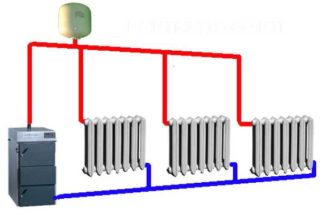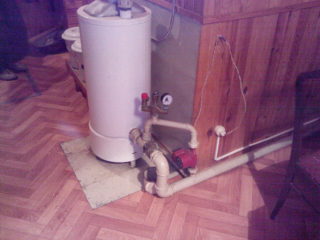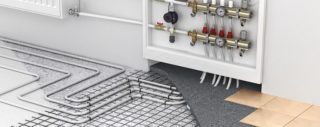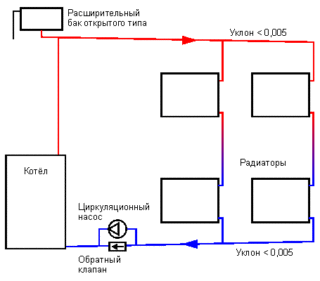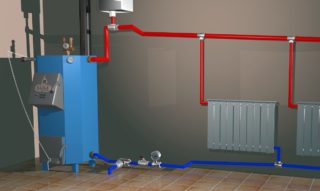In small private houses and apartments, heating is independent of electricity. For small towns and villages, a situation is typical when, for various reasons, a substation fails, wiring is damaged, etc. The natural circulation heating system does not include a single module that would work from the mains.
Features of the natural circulation heating system
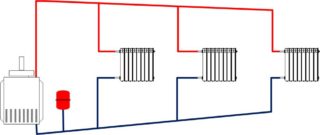
Any heating scheme includes several mandatory elements:
- The boiler that heats the water - gas, wood, peat. A prerequisite is piezo ignition, otherwise it will be impossible to start the device without electricity.
- The supply pipe supplies heated water to the radiators. Pipes are placed with a certain slope - 0.5–1 cm per 1 m, so that water can move by gravity. "Hot" water conduits are placed with a slope towards the radiators.
- Heating devices - batteries of any type. Through them, the main heat transfer occurs.
- Return pipe - through it the cooled coolant is returned to the boiler. “Cold” pipes are mounted with a slope of 0.5–1 cm per 1 m towards the boiler.
- Expansion tank - located at the highest point of the system. When water is heated, it increases in volume. The tank compensates for this excess.
The system operates as follows: the water heats up in the boiler, expands, its density decreases, and the liquid rises along the central riser. The expansion tank is filled to equalize the pressure between cold and hot water. Then, from above, water is lowered through the supply pipe to each battery, where it is cooled, giving off heat to air and surfaces. The cooled liquid moves through the return pipes to the boiler. Since the density of the cooled water is lower, returning to the boiler, it squeezes out the less dense heated liquid, causing it to rise.
In addition to the function of pressure compensation, the expansion tank performs another role. Together with water, air enters the pipes. When it accumulates, an air plug occurs, which does not allow the coolant to move through the pipes. However, in convective systems, due to the location of the pipeline under a slope, air bubbles rise into the expansion tank. Since this device is open and in contact with air, bubbles leave the system.
The design is simple, but requires very accurate calculations. Water moving along the pipe creates friction, slows down and gives off heat faster. When the direction changes - turns, branches, channels in the batteries - friction increases. If water resistance is not taken into account in the calculations, the system will not work.
Convective heating works well in small areas. Thus, you can burn one- or two-story private house or apartment. For a 9-story building, this option is not suitable.
Advantages and disadvantages of the system
Natural circulation provides the heating system with the following benefits:
- The main advantage is independence from electricity. Convective heating works in all conditions.
- With proper installation and care, the self-flowing version lasts longer than 30 years.
- Installation is very simple, routine inspection and repair also do not cause difficulties.
- High thermal inertia - a large volume of water circulates here. It cools more slowly and gives off heat longer.
- Convective water heating is silent: there are no electric pumps that generate noise.
- The power consumption is minimal. However, this is true if the pipes and the building are well insulated.
- The minimum cost of the system and installation.
It is not difficult to integrate a pump into the circulation circuit. This can be done during installation or later. When there is electricity, the heating works in forced circulation mode, and in its absence it automatically switches to the natural movement of water.
The gravity version has significant drawbacks, which significantly limits the application:
- The system is served only by small one-story or two-story cottages.
- To reduce hydraulic resistance, use pipes with the largest possible diameter. This makes installation difficult, and the cost of water conduits with a larger diameter is larger.
- Only steel pipes are recommended. It is allowed to use polypropylene. Other non-metallic models are prohibited.
- It is not possible to adjust the temperature in each room manually or automatically.
- Indirect heating boilers cannot be included in the scheme, which increases the cost of producing hot water.
- It is not possible to equip a warm floor.
The work of convective heating is significantly affected by constrictions. Do not use metal-plastic pipes, since they are connected by fittings whose diameter is smaller.
Types of heating systems
The heating circuit may include 1 or more circuits of different lengths, with different radiators. However, any option is a modification of only two models - one-pipe or two-pipe.
Single tube
The device is as simple as possible. The same pipe in turn brings the coolant to each radiator and returns to the boiler. The cheapest option and the most problem-free is heating only with pipes, without radiators. If batteries are included in the circuit, there should be a minimum of pipes and valves.
Water, sequentially moving to the last radiator, cools more and more. This feature is taken into account when calculating the number of sections.
There are 2 schemes of a single-tube version:
- With the upper connection - water enters the battery from above through the upper nozzle, exits through the lower. The efficiency of the system is maximum for water heating.
- With the bottom connection - the coolant enters the radiator from below and also exits through the lower pipe. The path of the water increases, so the heat transfer of the system is noticeably lower. Here you can not put radiators with a large number of sections. However, despite the lower efficiency, he prefers to install such a scheme in apartments, since it is more aesthetic.
The classic version can be upgraded by installing bypass - branches with a three-way valve and branches with cranes. With their help, you can adjust the flow of water to a different radiator and turn it off if necessary.
Double pipe systems
The option with a return pipe is called two-pipe. Hot water is supplied to the radiator under one pipe, and the cooled, from each heating device is discharged through the return pipe. The system is much more efficient: each radiator receives almost the same amount of heat. The degree of heating can be adjusted on each battery, if necessary, exclude it from the heating circuit. A big plus is a simpler calculation of the parameters of the pipeline and batteries.
Perform both top and bottom connection:
- In the first case, the pipes are located above the radiators.
- In the second, the feed pipe is located below the battery.This option is more aesthetic, but the pressure drop is too low, so the circuit is used very rarely.
In the calculations take into account the direction of water drainage. If it coincides with the direction of the hot liquid, a passing scheme, the cycle length is equal. In this case, the radiators heat up the same way. If dead-end, cold and hot water are used, they move in different directions, those batteries in which the cycle cycle turns out to be faster are heated.
How does the circulation pressure appear
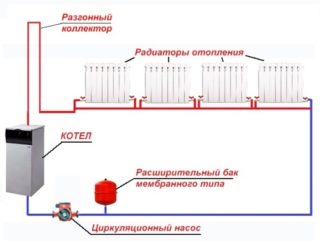
Moving water in convective heating provides only the difference in the density of hot and cold water. When heated, the density of the coolant decreases and it rises; upon cooling, it increases, and it displaces a warmer liquid. The greater the difference in the hydrostatic pressure of a column of cold and hot water, the higher the circulation pressure, the better the heating.
The main task in organizing the system is to achieve the maximum pressure drop.
- A mandatory element of the circuit is the acceleration collector or the main riser. This is a vertical pipe that rises from the heat exchanger to the top of the system. An expansion tank is mounted here - an open or closed diaphragm with an air valve for venting.
- The main riser must have a maximum temperature, so the collector is insulated. Its height is not more than 10 m. Ideally, the riser does not come into contact with the return pipes.
- To create a sufficient pressure drop, you need to create a large column of cold liquid. This is achieved by installing the boiler at the lowest point of the system. In a private house, the device is placed in the basement, in the apartment - in the recess. The higher the battery level above the boiler, the greater the pressure generated by cold water and the more actively displaces hot water.
To improve circulation pressure, batteries with the largest working surface are selected. The better the heat carrier transfers heat and the colder the water enters the boiler, the better the heating works.
The principle of building a heating system with natural circulation
The main parameters of heating with natural circulation are circulation pressure and hydrostatic resistance. The first indicator is calculated as follows:
P = h (p0-p1) = m (kg / cbm-kg / cbm) = kg / sqm = mmHgwhere:
- P - pressure in the system;
- h - height difference between the center of the lowest battery and the center of the boiler;
- p0 - the density of the heated liquid;
- p1- density of cold water.
The greater the difference in height, the higher the pressure drop. However, the indicator has a limitation of not more than 3 m.
It is practically impossible to calculate the value of the second factor - hydraulic resistance. The model that describes it is extremely complex and includes many variables. Here are limited to approximate calculations.
To improve the efficiency of the system, observe the recommendations:
- Pipes with the largest diameter are selected. In this case, the flow rate decreases somewhat, but the resistance decreases more strongly.
- Install as few shutoff valves as possible. Make sure that the scheme includes a minimum of twists and turns.
- With a lower connection, radiators must be equipped with Mayevsky taps to bleed off excess air.
- A metal pipe is used for the collector, since it is important to achieve maximum heating to create a pressure drop. The pipes serving the batteries may be made of polypropylene.
Proper thermal insulation improves the work of heating. The acceleration collector, supply and return pipes are isolated if they pass through unheated rooms.
